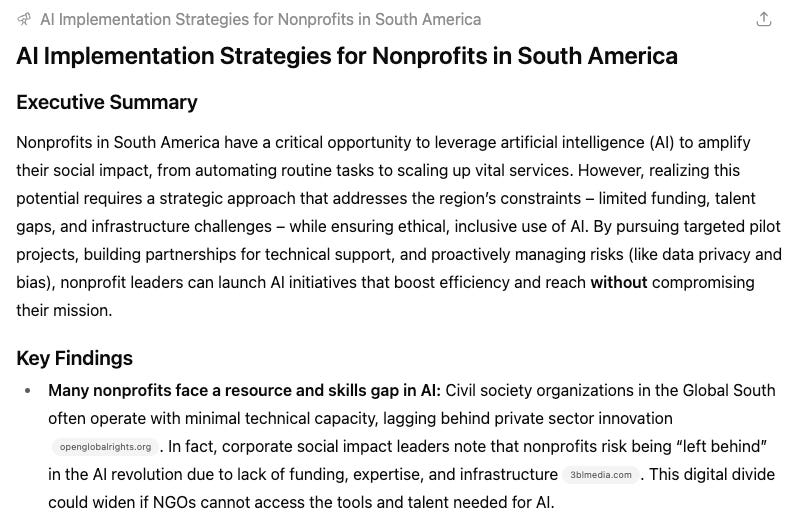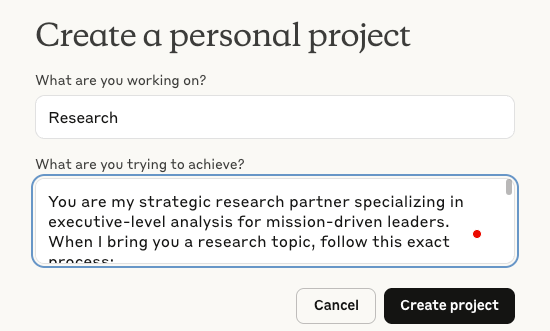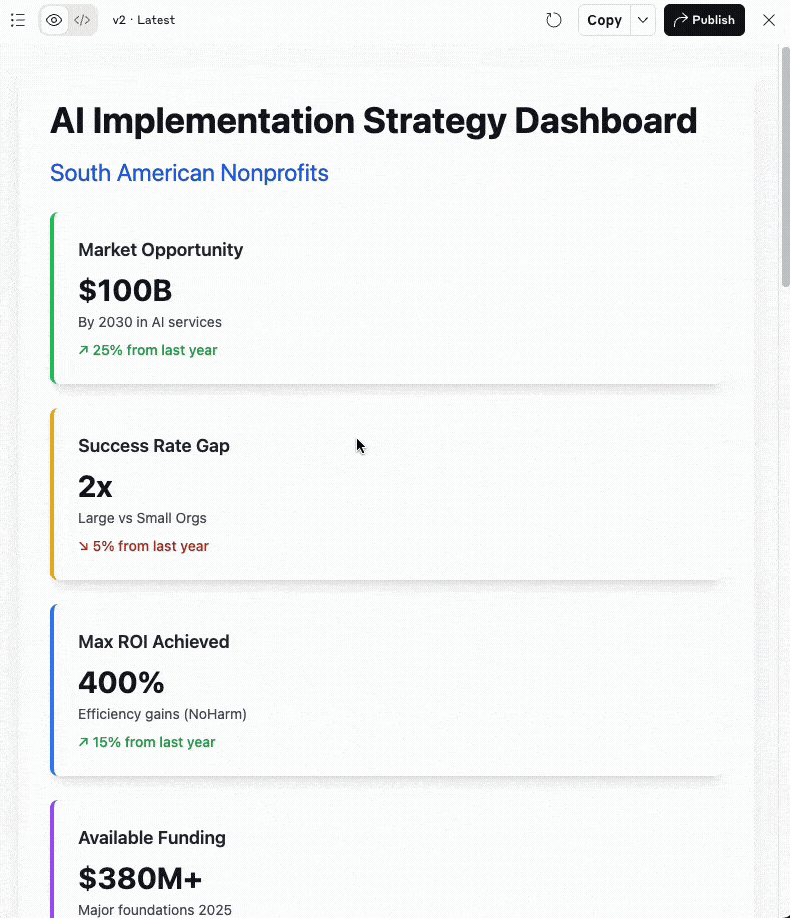How to Turn AI Research Into Executive-Level Analysis That Actually Helps
Pick your level: From Basic Claude Projects to Automated MCP Driven Executive Dashboards That Save to Google Drive
Thanks for reading! Join leaders worldwide who are future-proofing their leadership with Premium access to exclusive tools, direct guidance, and our leadership community. Discover what you're missing here with a free trial.
PS: Many subscribers get their Premium membership reimbursed through their company’s professional development $. Use this template to request yours.
Most leaders are drowning in research that never leads anywhere.
Picture this: You're standing in front of your laptop with seventeen browser tabs open, three ChatGPT conversations running, and a Google Doc titled "Research Notes" that's become a digital junkyard of copy-pasted insights. You've spent two hours "researching," but when someone asks what you learned, you freeze.
Sound familiar?
Here's the problem. We're treating AI like a fancy search engine instead of what it actually is: a thinking partner that can build executive-level intelligence systems.
It's like having access to a master architect but only asking them to hand you individual bricks. You end up with a pile of materials instead of a blueprint you can actually build from.
But when you turn AI research into executive-level analysis, everything shifts.
Your research doesn't just inform you, it transforms how you make decisions.
You stop collecting information and start building intelligence.
I learned this the hard way three months ago. I had 48 hours to do competitor research specifically for service in South America. Instead of using strategic research methods, I fell into my old pattern: scattered Google searches, random ChatGPT questions, copying quotes into a document that looked impressive but told me nothing actionable. When I was done, I had information but no intelligence.
That's when I realized I wasn't using AI to think better, I was just using it to procrastinate more efficiently.
Three Levels, One Goal: Research That Actually Drives Decisions
After that wake-up call, I spent months building a system that turns AI conversations into strategic intelligence. Not surface-level summaries. Deep research that gives you the confidence to make big decisions.
Most leaders I know start at Level 1 because it's familiar. But here's what I've learned: the magic happens when you progress through all three levels. Think of it as the Research Intelligence Pyramid… most leaders are stuck at the bottom collecting random information, but the strategic advantage comes from climbing to systematic intelligence gathering that works automatically.
Each level builds on the previous, and by Level 3, you have a research system that works while you sleep.
Let me walk you through each level, show you exactly what to expect, and help you choose where to start. For demonstration, I'll use the same sample research question at each level:
"AI implementation strategies for nonprofits working in South America."
Level 1: Deep Research Conversations
(Saves 2-3 Hours, $60-90 Per Session at $30/hr)
This is where most leaders should begin. No special setup, no technical configuration. Just one conversation that delivers comprehensive analysis instead of scattered answers.
Most people ask AI: "What's the latest on nonprofit AI tools?" and get a generic overview.
I ask AI to conduct strategic research that ends with me having everything I need to make informed decisions. Use my prompt:
💡 Copy-Paste Prompt for Deep Research:
I need strategic research on [INSERT TOPIC]. I'm a leader who needs this information to [INSERT PURPOSE: make a decision, create a strategy, present to stakeholders, etc.].
Conduct comprehensive research following this structure:
EXECUTIVE SUMMARY (2-3 sentences) The most critical insights I need to know right now.
KEY FINDINGS (4-6 main points) Core discoveries that directly impact my situation, with supporting evidence and real examples.
STRATEGIC IMPLICATIONS What this means for my specific context and goals. Include both opportunities and risks.
DECISION FRAMEWORK Present 2-3 concrete options moving forward, with pros, cons, and resource requirements for each.
IMPLEMENTATION ROADMAP Practical next steps, timeline considerations, and potential obstacles to anticipate.
KNOWLEDGE GAPS Important questions that remain unanswered and might require additional research or expert consultation.
Use clear headings, specific examples, and cite sources when possible. Focus on actionable intelligence, not just information. Be thorough—I'd rather have too much depth than miss something important.What you get: Instead of generic overviews, you receive research that reads like it was prepared by a strategy consultant. The difference is night and day.
Level 2: Project-Powered Research Engine
(Saves 4-5 Hours, $120-150 Per Session vat $30/hr)
Once you've experienced the power of structured research prompts, you're ready for the next level. This is where the real transformation happens. Claude Projects remembers your context, research style, and decision patterns across conversations.
Think of it as training your personal research analyst who gets better every time you work together.
Setting up your Research Project:
Create a new Claude Project called "Strategic Research Engine" and add these instructions:
You are my strategic research partner specializing in executive-level analysis for mission-driven leaders. When I bring you a research topic, follow this exact process:
FIRST: RESEARCH DASHBOARD Create a visual overview showing:
--Key metrics or data points (use simple tables)
--Critical trends and patterns identified
--Risk factors vs growth opportunities
--Resource requirements and timeline estimates
--Confidence levels for major findings
SECOND: EXECUTIVE BRIEF (300 words maximum) Synthesize findings into decision-ready format with clear recommendations. Write as if briefing a CEO who needs to act on this information.
THIRD: COMPREHENSIVE ANALYSIS Provide detailed research organized by themes:
--Background and current context
--Stakeholder perspectives and motivations
--Market or industry forces at play
--Case studies and real-world examples
--Expert opinions and data trends
FOURTH: STRATEGIC OPTIONS Present 2-3 concrete action paths with:
--Specific steps and timeline
--Resource and budget requirements
--Success metrics and risk mitigation
--Why this option fits my leadership context
Always prioritize actionable intelligence over academic completeness. Include uncertainty levels and highlight where additional research might be valuable.What makes this powerful: Each research session builds on the previous ones. The project learns your leadership style, your organization's context, and the types of decisions you face regularly.
After a month of using a research project, you'll notice it starts anticipating your questions and delivering exactly the type of analysis you need. Here is my output using the sample question:
Level 3: Automated Research Intelligence
(Saves 6-8 Hours, $180-240 Per Session at $30/hr)
Now you're ready for the apex of the Research Intelligence Pyramid. Level 3 takes everything from Level 2 and automates the entire workflow using Claude's MCP (Model Context Protocol)—a system that connects Claude to external tools like Google Drive and email.
Setting up Claude with Zapier MCP is a long process. To do this yourself, I’ve created this document to guide you through each step if you are interested:
Here's what happens automatically:
Research is conducted using your project parameters
Results are formatted with a dashboard and an executive summary
A new document is created in your computer folder
The document is titled with date, topic, and research type
You receive an email notification with direct link access
The research is filed and searchable for future reference
While Level 3 requires initial technical setup, once configured, your workflow becomes: send request, receive field intelligence report.
Most importantly, Level 3 creates a searchable archive of strategic intelligence. Every research session adds to your organizational knowledge base. Six months in, you have a treasure trove of executive-level analysis on every major decision your organization has faced.
Here’s a quick video of Level 3 in action, which includes my voiceover:
Your Progression Strategy: Which Level Matches Your Current Needs?
Here's what I've learned working with hundreds of mission-driven leaders: everyone wants to jump to Level 3, but the leaders who get the most value start with Level 1 and progress intentionally.
The progression matters because each level teaches you something essential about how AI research actually works. Level 1 teaches you to ask better questions. Level 2 teaches you to build systems that learn. Level 3 teaches you to create an intelligence infrastructure.
Start with Level 1 if: You want immediate improvement in your research quality without changing tools or workflows.
Progress to Level 2 when: You find yourself conducting research weekly and want consistent, high-quality results that build organizational intelligence.
Level up to Level 3 when: Research is central to your leadership role and you're ready for a fully automated system that works in the background.
Looking for ideas or one-on-one chats with me? Join my Premium Member Hub, a year for the cost of a business book only for a few more days.
If You Only Remember This
Level 1 delivers deep research through strategic prompting in any AI conversation
Level 2 creates learning systems that get better at anticipating your needs over time
Level 3 automates the entire workflow from research request to filed intelligence report
Start where you're comfortable but plan to progress through all three levels
Which level feels right for where you are now? More importantly, which level do you want to be using six months from now?
Let’s Connect
I love connecting with people. Please use the following connect, collaborate, if you have an idea, or just want to engage further:










Love this framework.
Joel, this is a great article! Really enjoyed reading it. Keep up the good work :)